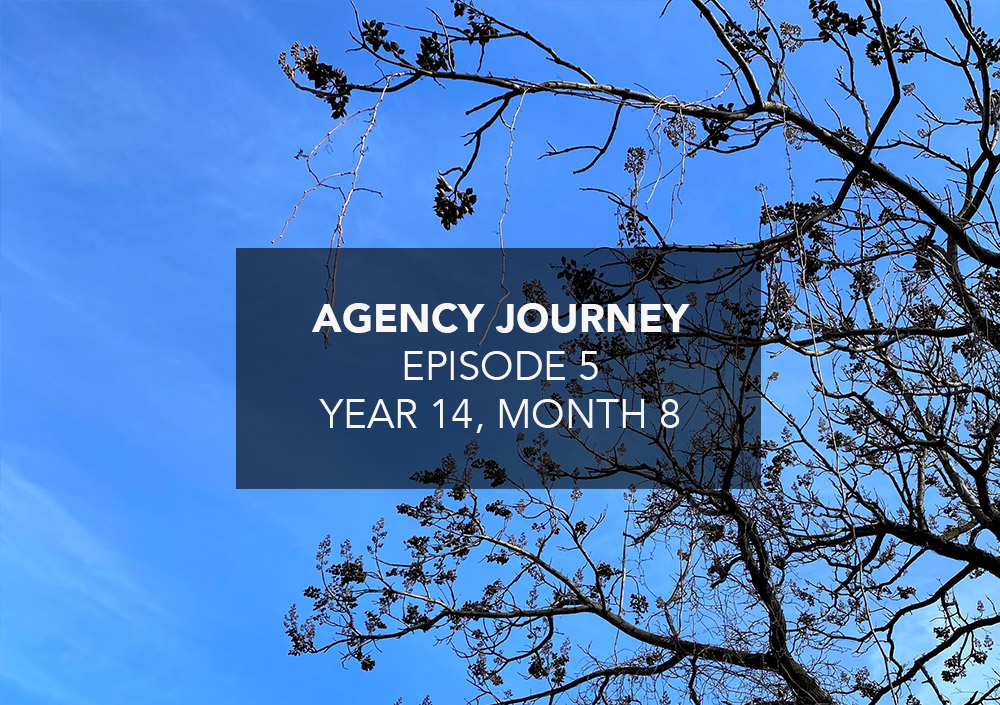Refreshed and back from the holiday break, it’s been a very fast-paced and intense January.
Let’s jump in to episode 5.
About Agency Journey: This is a monthly series detailing the happenings of my agency Barrel, founded in 2006. You can find previous episodes here.
Highlights
A Week of Looking Ahead
The week of January 11th was a crucial “planning” week to help us prioritize initiatives and set goals for 2021. One session, two and half hours long, was with our team leaders. We shared our proudest accomplishments as a team from 2020 and then engaged in a SWOT (strengths, weaknesses, opportunities, and threats) exercise, each taking turns and sharing thoughts for each quadrant. It was great to have everyone contribute and surface things that others may not have realized were assets or challenges.
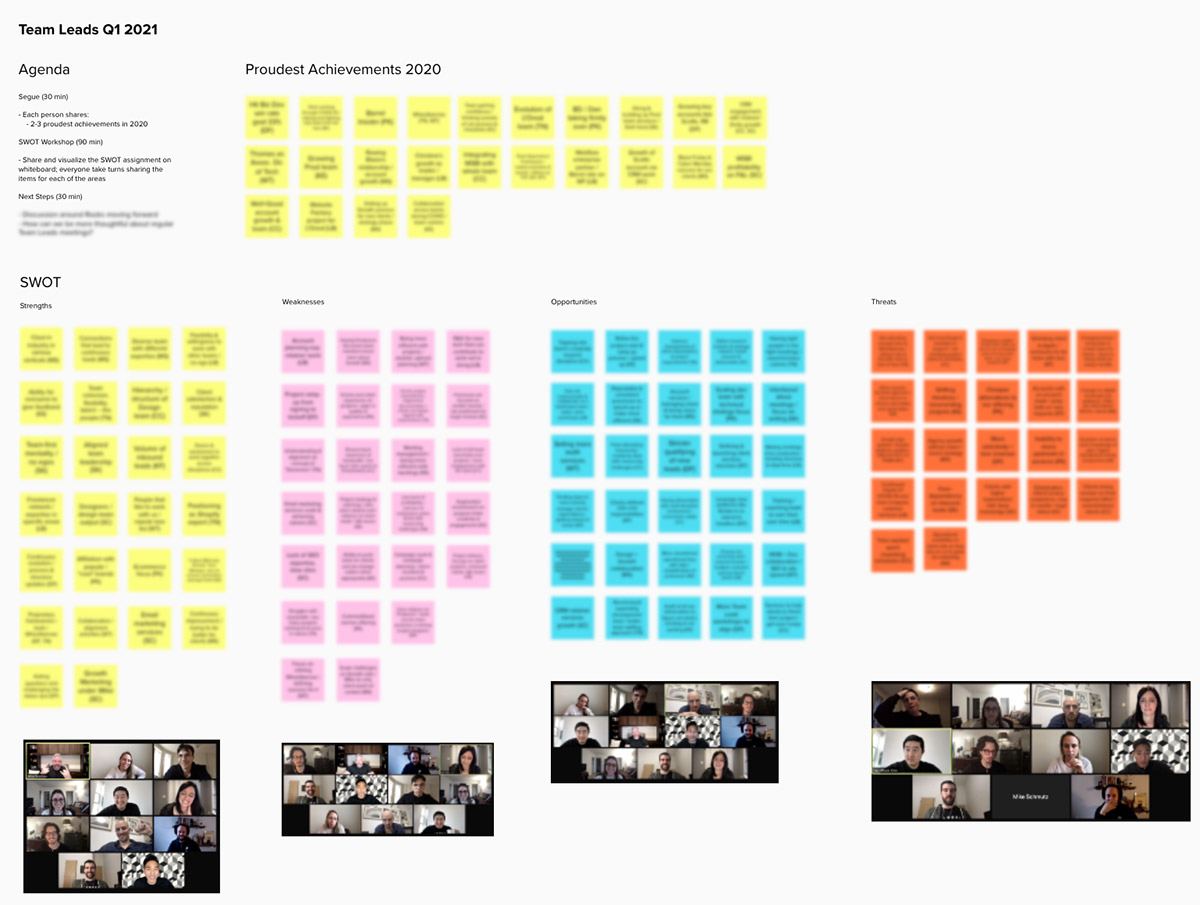
We used Mural to document our Team Leads meeting. We mixed up the order of people’s Zoom windows and embedded the screenshot to use as a way to take turns sharing.
The meeting ended without a clear next step for the team leaders, which was poor planning on my part. As the primary organizer for this meeting, I didn’t explicitly frame the SWOT exercise as an alignment and information-gathering meeting rather than something to draw concrete action items from. The truth is, we’re already engaged in a number of initiatives and internal projects that are addressing different types of opportunities, weaknesses, and threats. However, the communication gap was my fault and a good learning for next time.
A couple of days later, the partners convened for an all-day planning session. Our agendas are loosely based on the EOS (Entrepreneurial Operating System) format popularized by Geno Wickman’s book Traction. The first day focuses on planning for the entire year and the second day is for the quarter.
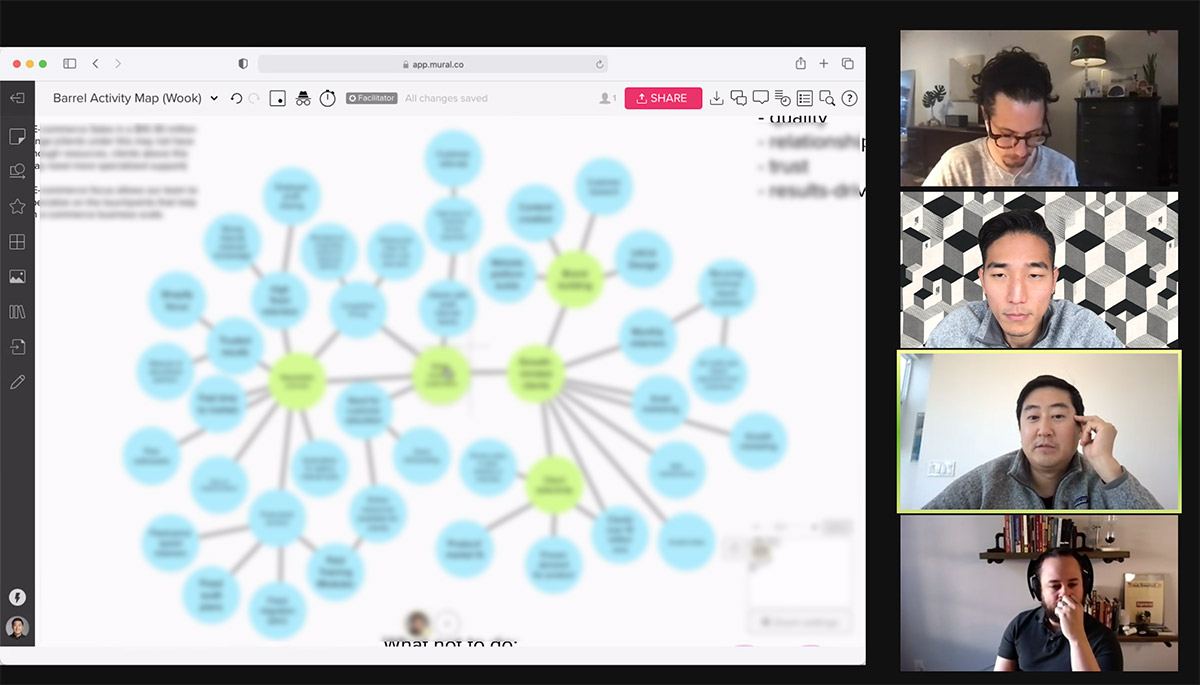
For our annual planning meeting, each partner took turns sharing their version of the activity map based on Michael Porter’s “What is Strategy” paper.
We kicked off with an in-depth discussion of the article “What is Strategy?” by Michael Porter and aligned on the concepts of strategic positioning, fit among unique set of activities, trade-offs, the types of positioning (variety-based, needs-based, and access-based), and other themes. Then we shared with each other the primary prep work for the meeting, which was an Activity Map for Barrel that embraced Porter’s strategic positioning framework. The exercise was incredibly energizing in that it forced us to think deeply about Barrel’s future state and the ways in which we would need to rethink many of our existing activities.
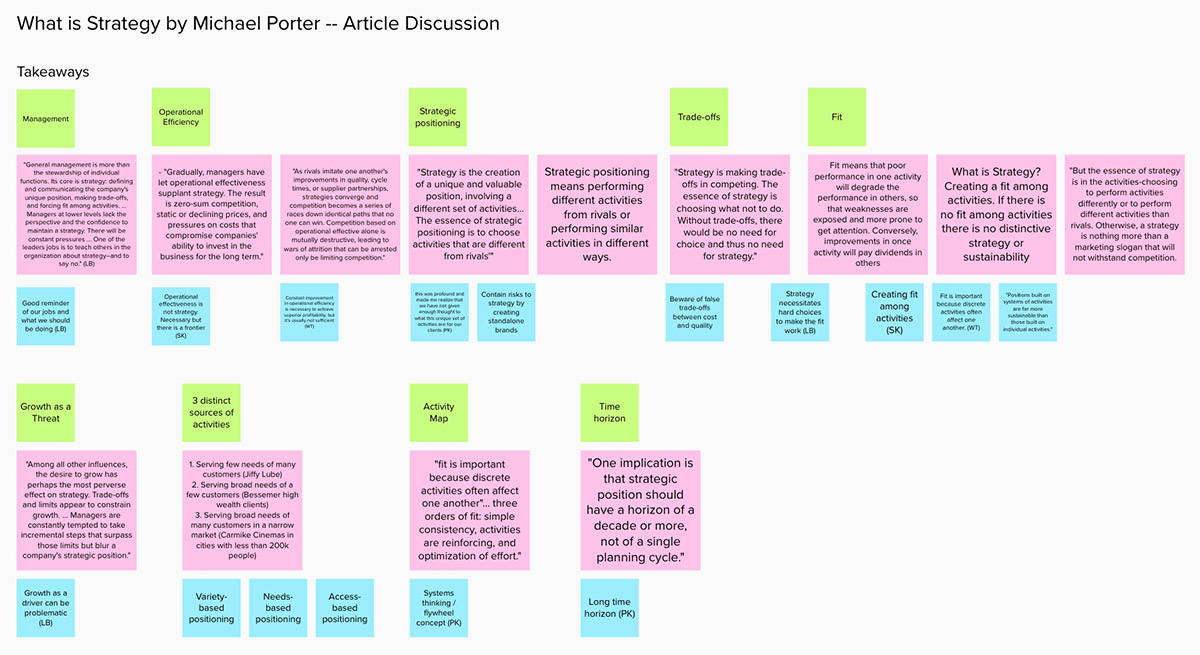
We shared our favorite highlights and key takeaways from “What is Strategy?” by Michael Porter.
The latter part of the day was focused on revisiting our Core Values and whether or not the matched up well with our mission statement (“We help brands build meaningful connections with their customers.”). Turns out that our mission statement, which was rolled out last year, didn’t line up as well with our core values, which have been around for much longer. We imagined a blank slate and brainstormed behaviors and principles we would want to embrace for the future. The ideas were really inspiring and the exercise encouraged us that by the end of this year, we would have worked through a new set of Core Values with the team. No need to rush right now, we agreed, but we’re at a good starting place.
The next day, a half day, was spent revisiting the forward-looking ideas of the previous day and distilling them into actionable initiatives for the next 90 days. A key initiative that came out of our discussions was the need to better streamline the process of building our Shopify websites and codifying stronger standard operating procedures along with buy-in and participating from the team to design such processes.
We also established business goals during the week including revenue and profit targets and win rate goal for new business. We fell a bit short of our revenue and profit goals last year but the investments we made in building out a more robust team structure and leadership layer should start to pay off this year.
Our Director of Client Services Starts
Last year, I spent a great deal of time recruiting and interviewing for our Director of Client Services role. We were very excited to welcome Kate Fulks as our new Director of Client Services. Kate had been a Managing Director at Havas Helia, an agency focused on data-driven CRM communications and part of the larger Havas network. We were super impressed with her depth of client services experience and the way she led client services teams throughout her career.
Kate’s been working quickly to get the lay of the land at Barrel and to identify areas where she can make impact. As we continue to grow client relationships and their overall lifetime value through multiple projects and retainers, the Client Services team will play an important role in leading strategy and managing the client experience.
Profit Share Goes Out
About a year ago, I had begun to sketch out some ideas on a profit sharing plan for our team. The desire to roll out such a plan came from the belief that profit sharing would A) more deeply engage our team with the business side of the agency and B) tie an incentive to transparent business performance.
To lay the groundwork for this plan, we had to first get comfortable sharing financial figures with the team, a practice that we had not consistently held in our company history. Towards the end of 2019, we started to openly share our revenue and gross profit numbers as well as our goals for 2020. Since then, we’ve shared updates on the company’s financial numbers each quarter, showing how it’s tracked vs. the goal as well as the previous year.
The profit sharing plan was all set to go in March but the pandemic forced us to put it on hold as we navigated various business uncertainties. When things calmed down a bit over the summer, we decided to finally roll it out. We held a Town Hall to review the Profit Sharing Plan with the team, fielded questions, and even shared a spreadsheet they could use to calculate their potential profit share amount based on a few different business outcomes for the agency (underperform, base, and outperform).
We decided to start off the program conservatively by pegging the profit share pool at 2% of gross profit. We simplified gross profit to be all client revenue minus all people costs, which include full-time employees and contractors. Our explanation to the team was that people costs are largely a function of how efficiently we do our work and that being smart about process and the use of contractors can improve margins and leave more for the pool.
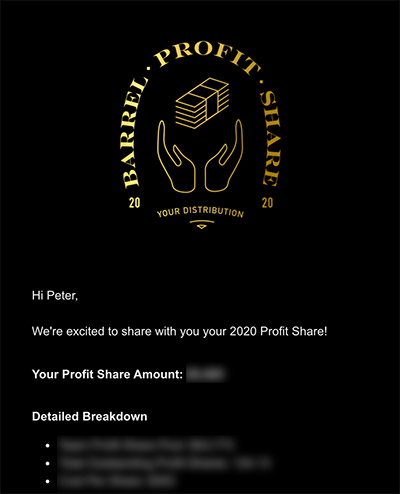
A screenshot of the top portion of a test email personalized for each employee receiving the profit share. Credit to Lucas Ballasy for the graphic.
Almost half a year later, we had our first ever Profit Share Distribution. To celebrate the occasion, we put together a special email campaign to the team that came personalized with their specific profit share amount along with explanations on how it was calculated. It was cool to see this come to fruition, and my hope is that the Profit Share Pool amount increases dramatically in the years to come.
A Few of Sizable Investments
We pulled the trigger on a few things that we hope will pay off in the long run. The first is a membership for myself and Sei-Wook in Collective 54, a membership organization for owners of professional services firm. I got an email from them soon after I sent a note via LinkedIn to its founder Greg Alexander, who authored the book The Boutique, an excellent guide to growing, scaling, and selling a professional services firm. I found The Boutique to be so helpful that I shot Alexander a “thank you” note. Before long, I was convinced to join Collective 54, which offers various resources and programming to help professional firm owners grow their businesses. So far, I’ve found the topics they cover to be very helpful and a bit different than what I’ve gotten from the more digital agency-focused orgs I belong to.
The other investment is an on-going relationship with Level10 CFO, a fractional CFO firm. After nearly 15 years of managing the business off an Excel file (a robust one, but still, just an Excel file), Sei-Wook and I realized we really needed to modernize our financial software stack and workflows to scale and get better insights about our business. With Level10, we’ll be shifting over to Quickbooks Online and working to automate various processes while cutting down on the amount of manual data entry, which has become a bigger and bigger issue for us in recent years. We’ll also be working to get a more accurate accrual-based view of our finances versus our home-brewed variety. Much overdue and something we probably should have done years ago, but better now than never.
Lastly, we signed up for a 6-month engagement with Novus Global, an executive coaching firm that came highly recommended by a friend. After doing due diligence through reference calls and doing some reading on the frameworks and philosophies their coaching principles are based on, I recommended to the partners that we make the investment for ourselves and 6 of our team leads. This would entail 3 coaching sessions per month for them (4 for the partners) for the next 6 months as well as 8 90-minutes introductory learning sessions for the entire team. While it’s a high cost, I’m optimistic that the gains from it will be reflected in our business performance as well as positive impacts on the culture. Looking forward to reporting back on this in the coming months.
Top of Mind
Project Delays and Their Impact
More so than usual, we’ve felt a drag from a large number of projects stretching beyond their original timeline. The reasons are varied: extra feedback rounds to work out creative differences, delays on the client side in getting us content, challenges in scheduling time for client stakeholders to provide final sign-off, dependencies on other agencies/consultants/in-house teams who’re tied up, etc.
Things usually get worked out, projects launch, and clients are generally happy. However, as the number of projects hanging in limbo have increased, the impact has been felt more piercingly than in the past.
Here’s a troubling scenario (fictional, but drawing from real situations) that’s popped up more than once in recent months:
- A designer is staffed to work on a couple different projects and scheduled to be fully utilized.
- News from the client on one project pushes out a key meeting an extra week, preventing the designer from moving on to the next piece of the work. One another project, the branding agency that’s supposed to deliver a style guide needs a couple more weeks, also preventing the designer from getting started on the work.
- A designer who was scheduled to be fully utilized for the next couple of weeks is now nearly free the next week and uncertain about the week after that.
- The team scrambles to find work for the designer to do, but aside from helping out on a small piece of work, there’s nothing much to ramp up on with uncertainty surrounding the other projects. The designer spends some time doing case studies and sprucing up the agency website.
- This scenario is happening in various parts of the agency. In resourcing meetings, everyone looks like they are too busy to take on anything new. When a new project or assignment comes in, freelancers are hired to take on the work.
- Net effect: internal resources sit idle while the agency pays out of pocket for freelancers to do work.
- One of the designer’s projects was scoped as fixed-fee with no provisions for prolonged timelines especially as the client emphasized how urgently they needed things to launch and how quickly they wanted to move. The other project, signed as a time & materials engagement, is based on hours billed. Unfortunately, delays and not getting to work on the project means no hours are billed. In both cases, the engagements are structured for maximum pain in the event of delays.
Our retainers, where clients buy a bucket of hours per month on a use-it-or-lose-it basis, seem to be the most “protective” type of engagement. One idea that we’ve been throwing around is to potentially structure every project as a retainer. This way, the client is incentivized to keep things moving as efficiently as possible. Of course, it’s easier said than done. Retainer engagements have their own challenges and need to be very specifically defined with client-aligned expectations. Otherwise, the agency can risk overpromising on deliverables for the amount of hours available that month.
Lots to continue observing and experimenting on this front. Our team is tackling it from various angles and there is no Gordian Knot solution to this.
Team Structure, Utilization, and Leverage
With various departmental restructures, promotions, and an expanded management layer, the makeup of our team has grown to be heavier at the top in the past 18 months.
While there have been clear benefits to having more managers and team leads, we’ve noticed that utilization has been down across the board. We’re pretty sure the reason has to do with the ratio of juniors vs. senior roles, which means it’s a problem with leverage.
We’ll have to do to a better job of identifying which departments have the project work and billable hours to support new junior staff members. By mapping out utilization and capacity across all the departments along with the count of team members at each level (e.g. Director, Senior, Mid-Level, etc.), it’s clear that certain departments are suffering from overloaded junior and mid-level team members.
While the solution may seem obvious, the actual execution will take time and effort. It’s not as if we can snap our fingers and hire interns and young talent right away. Once we’ve found the right candidates through recruiting and interviews, we’ll have to invest considerable time upfront to train them before they reach full utilization. Certain departments, like our Creative team, have the infrastructure and continually produce a pipeline of junior talent but other departments need to invest in building out a repeatable system and make internships and junior-level hires a more regular occurrence.
Last thing I’ll note here is that we use of contractors across all the departments on a regular basis. When done right, this can be a profitable approach and provide additional leverage by filling in the non-senior & non-manager roles. However, situations like project delays, resourcing jams, or misalignment on scoping have led to overages and unplanned use of contractors that have cut into margins. We’ve rolled out processes to bring more oversight when it comes to contractor hires (e.g. did we exhaust all internal resources? what happens if we just wait another week instead of rushing to add a contractor?) which, by adding some friction, has allowed us to be more mindful of costs.
Shared with Partners
“There are organizations that are great at what they do, that are relentless at it. But it turns out there are very few that are great and relentless at people development. Organizations (and management science), for example, talk about “continuous improvement.” But it is one thing to be relentless about continuously improving the processes by which work gets done; it is quite another to be relentless about continuously improving the people who do the work.” (Robert Kegan, Lisa Laskow Lahey, An Everyone Culture)
I’ve been enjoying reading An Everyone Culture, a book about deliberately developmental organizations (DDOs) that examines the practices and cultures of three unique companies that have embraced the idea that people bring their whole selves to work and that a great work environment pushes people to continue growing. This quote was a great reminder that oftentimes, as we’re laser-focused on improving the mechanistic elements of the business, we ought to be really thinking about ways to develop and grow our people.
Everything that happens once can never happen again. But everything that happens twice will surely happen a third time. (Paul Coelho, The Alchemist)
This quote has stuck with me as I see it happening time and time again. Whenever a situation feels like it’s repeated itself–the way a project went, the way an employee reacted, or the way a certain deal was won or lost–there’s a high degree of probability that it’ll happen yet again. Recognizing repeat situations quickly and making the effort to understand why they happened again is, I think, a very productive exercise, especially if it’s something that’s worth avoiding in the future.
“Do not speak ill of others. A knight does not spread news that he does not know to be certain, or condemn things that he does not understand.” (Ethan Hawke, Rules for a Knight)
I had some dark moments towards the end of 2020 when I was feeling more negative than usual, most likely a result of stress and some bad social media consumption habits. My negativity usually showed up in chat messages to my partners where I would have gripes about all kinds of things ranging from not having made as much progress as I thought we should have or comparing our situation unfavorably to other agencies. I nitpicked a lot of stuff and got on my partners’ nerves. Sei-Wook confronted me gently and helped me become more self-aware of the toxicity. I regretted my behavior and apologized to the rest of the partners as well and after a day of feeling shameful, I’ve since been a lot more positive and mindful of my words. This quote, which came a couple weeks after the incident, was a reminder to be a good knight and don’t talk shit in general.
